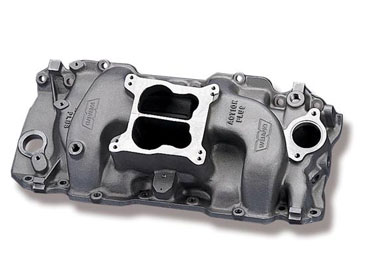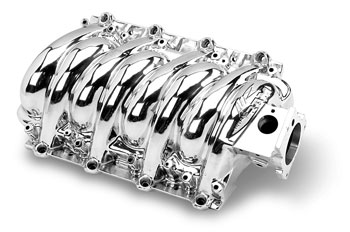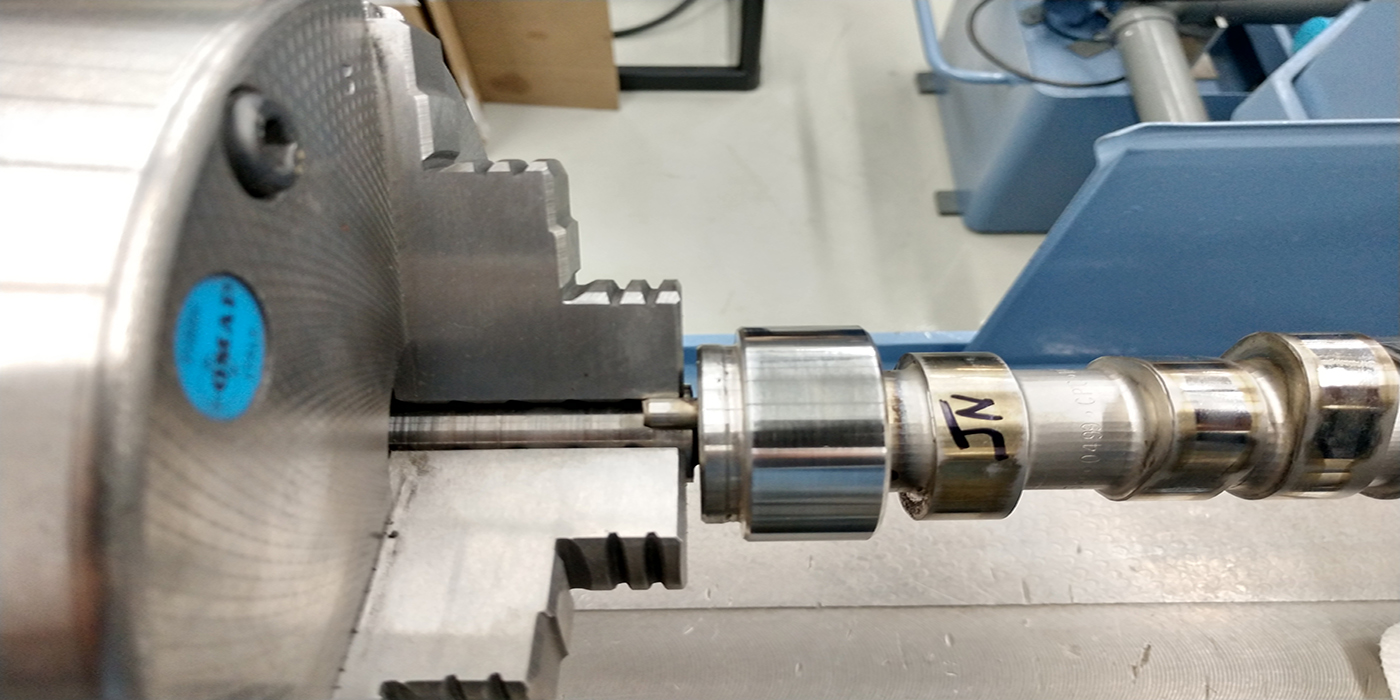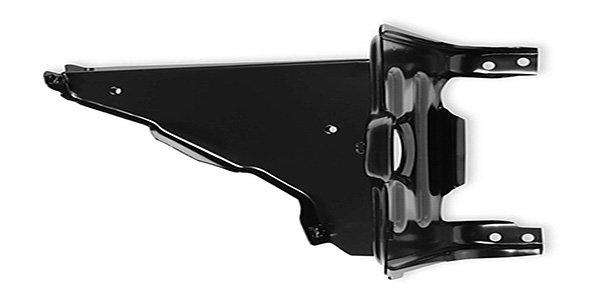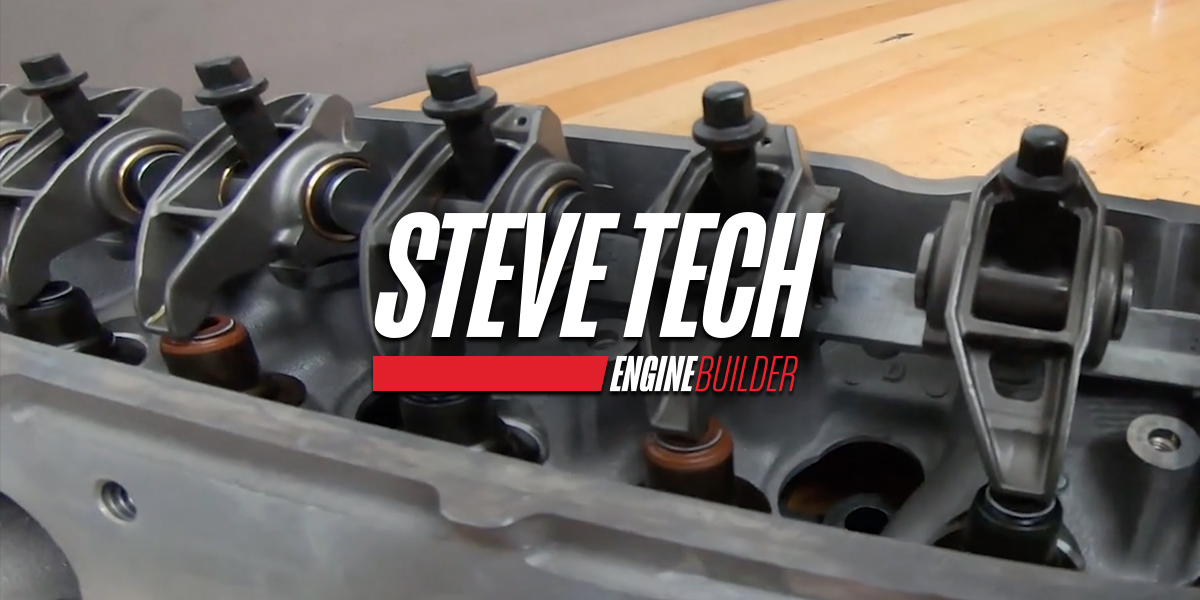An intake manifold is more than the plumbing that connects the
carburetor or throttle body to the ports in the cylinder head. It is an
integral part of the induction system that has to match the airflow
characteristics of the cylinder head and camshaft, as well as the
displacement and rpm range of the engine.
A well-designed manifold that is properly matched to the engine’s
requirements will make more torque and horsepower than a manifold which
is mismatched to the engine.
Stock intake manifolds are often a compilation of compromises. Stock
manifolds are typically designed to minimize manufacturing cost, to
accommodate emissions fittings, to fit a tight engine compartment with
limited hood clearance, and to provide good low- to mid-range
performance, fuel economy and emissions. Most stock engines spend 95%
of their running time between idle and 3,000 rpm, with rare bursts
above 5,000 rpm.
Consequently, if the engine is modified with a hotter camshaft, larger
carburetor or throttle body, and/or bigger heads, the stock manifold
will usually run out of air above its original design speed and hinder
power rather than build power.
As an example, the stock intake manifold on a Chevy 5.7L with tuned port injection, or the one on a stock Ford 4.6L V8
are both well designed for low to mid-range torque and power. In fact,
each will usually out-perform most aftermarket manifolds at lower
engine speeds. But if the engine is being modified to make more power,
the stock manifold usually runs out of air above 5,000 rpm and becomes
a restriction.
Dual- and Single-Plane Manifolds
On a V8 engine
with a two-barrel or four-barrel carburetor, most stock manifolds have
a split-plenum, dual-plane or “180 degree” configuration. Four of the
cylinders (two on each side) draw from one of the primary barrels in
the carburetor, and the remaining four cylinders draw from the other
primary barrel. The intake manifold essentially splits the V8 engine
into two V4s. The reason for doing this is to keep intake runner
velocity high so the cylinders will fill quickly and produce maximum
power and torque at low- to mid-range rpm.
This design, though wearing the “stock” label, isn’t necessarily
bad. A performance manifold that is designed for a street application
will often retain the split-plenum or dual-plane design for this same
reason. These types of manifolds can be a good choice for heavier
vehicles with automatic transmissions, stock gearing and engines that
won’t rev much beyond 5,500 to 6,500 rpm.
But if an engine has a longer duration camshaft, stiffer valve
springs, bigger cylinder heads and gearing for revving to 7,500 to
8,500 rpm or higher, an intake manifold with an open plenum,
single-plane or “360 degree” configuration is usually the best choice.
Opening up the plenum allows all of the cylinders to pull from all the
barrels in the carburetor or throttle body for more airflow at higher
engine speeds. This makes a significant improvement in mid-range and
high rpm power, but may sacrifice some low-end throttle response and
torque. Even so, a well-designed single-plane manifold will almost
always outperform a split-plenum dual-plane manifold from 2,500 rpm and
up.
Is Bigger Better?
The plenum in a stock manifold
is typically smaller to keep air velocity high. Likewise, the
cross-section of the runners is also small to keep the air moving at
maximum speed into the cylinder ports. This provides good idle quality
and throttle response, but also limits how much air the manifold can
flow at higher engine speeds.
Eventually the speed is reached at which the engine will try to pull in
more air than the stock intake manifold can flow. That’s when the stock
intake manifold needs to be upgraded to a performance manifold with a
larger plenum and larger runners.
One manifold manufacturer said for maximum high rpm performance, the
plenum volume should be equal to or greater than the engine’s
displacement in cubic inches — especially on a stroker motor.
In recent years, the popularity of stroker kits combined with the
availability of larger and larger displacement aftermarket engine
blocks has created a whole new generation of monster-sized motors.
We’re now seeing small block Chevys with displacements over 427 cubic
inches, and big block Chevys with displacements well over 600 cubic
inches. Consequently, performance intake manifolds that were designed
for small block and big block motors of a decade ago may not have
enough plenum area and runner volume to keep up with today’s extreme
engines.
So, intake manifold manufacturers have been redesigning their
products to better accommodate the increased breathing requirements of
today’s larger displacement stroker motors. The latest “improved”
manifolds can often generate an additional 20, 30 or even 50 or more
horsepower on many of these larger displacement engines compared to
what was possible using an older manifold design.
Runner Length
Runner length also affects the rpm
range where an engine makes the most power. Longer runner lengths have
a “ram” effect that helps keep the air moving forward as the intake
valves open and shut. When an intake valve opens, there is a short lag
before the cylinder starts to pull air through the runner into the
combustion chamber. A longer runner helps maintain the inertia of the
air column so it will fill the cylinder faster.
When the intake valve slams shuts, the momentum of the incoming air
hits a roadblock, and a pressure wave rushes backwards through the
intake port and runner. A longer intake runner tends to keep the air
moving in the right direction in spite of the reversionary pressure
pulse that is trying to push it backwards.
Shorter runners, on the other hand, usually flow better at higher
engine rpm. Reducing the length of the runners may allow the engine to
make more power at the top end, but the trade-off may be a loss of
power and torque at lower speeds. When choosing an intake manifold,
therefore, the runner length should match the engine rpm range where
the engine is built to make the most power. If you are building a low
rpm torque motor, you want an intake manifold with longer high velocity
runners. On the other hand, if you are building a high revving motor,
you will probably want a manifold with shorter runners or runners with
a larger cross-sectional area to flow more air.
Runner Curves and Manifold Heat
Another important
factor that influences airflow and how much torque and power an engine
can make is the angle and curvature of the intake runners. In an engine
with a carburetor, the intake manifold should not have any sharp turns
because it can cause the heavier droplets of fuel to separate from the
air/fuel mixture. This is not as critical in fuel injected engines
because only air flows through the manifold. The fuel is sprayed
directly into the intake ports by the injectors that are mounted in the
intake manifold just above the ports.
On carbureted engines, the intake manifold is “wet” and contains fuel
droplets. When a cold engine is started, additional heat is needed to
help vaporize the fuel. An exhaust crossover passage is often
incorporated into the stock manifold to redirect exhaust under the
plenum so the manifold will warm up quickly. On a performance engine,
you don’t want heat in the intake manifold because heat decreases air
density and power. So many aftermarket performance manifolds eliminate
the heat crossover passage. Some manifolds raise the intake plenum and
runners away from the engine so air can flow under the manifold to help
keep it cool.
A fuel-injected engine also does not require any heat in the intake
manifold to aid fuel vaporization because the manifold is “dry” (no
fuel vapor). This means the incoming air can be cooler and denser to
produce more power (which is another advantage of fuel injection in
addition to better cold starting). This also means the intake manifold
can be made of lightweight plastic since the manifold does not have to
withstand heat like a metal intake manifold on a carbureted engine.
Plastic intake manifolds are common on many late-model engines, and
one of the advantages of using plastic (besides saving weight) is that
it can be cast to optimize airflow.
One of the disadvantages of a plastic manifold, however, is the risk
of breakage if the engine backfires — which can be a danger when an
engine is fitted with a nitrous oxide system. Plastic manifolds also
require an entirely different casting process, so that’s why most
aftermarket intake manifolds continue to make their products out of
cast aluminum, including manifolds for late-model fuel injected engines
that have stock manifolds made of plastic. They say an aluminum casting
provides strength, can be polished, plated or coated, and can be easily
ported and modified.
Runner Design
The angle at which the runners in
the intake manifold line up with the ports in the cylinder head should
be as straight and smooth as possible to optimize airflow. That’s why
“high-rise” intake manifolds produce more power than “low-rise”
manifolds. The runners in a high-rise manifold have a straighter shot
at the ports in the cylinder head. The incoming air does not have to
change direction as much, so it flows more easily into the intake port
and combustion chamber. And if the ports in the intake manifold are
carefully matched to those in the cylinder heads, there will be no
sharp edges or misalignment to disrupt airflow.
Variable Displacement Intake Manifolds
To increase
engine torque at low rpm and power at high rpm, some late-model engines
have variable displacement intake systems. The intake manifold has two
sets of runners — long ones that are used at low engine speed to keep
air velocity high, and shorter runners that open up at high rpm to
increase total airflow. This is accomplished by using a “tuning valve”
in the intake manifold plenum.
At low speed, the tuning valve is closed and forces air to flow through
a longer set of intake runners. Above a certain engine speed, or as
engine speed and load increase, the PCM changes the position of the
tuning valve and opens up additional runners for increased airflow. The
valve is usually controlled by a solenoid or stepper motor mounted on
the intake manifold. On a V6 or V8 engine, there are often two control
valves.
One of the first engines to use this setup was the Ford Taurus
with the Yahama-designed SHO engine. Since then, it has become common
on many import engines as well as many Ford and other domestic engines.
Some aftermarket intake manifold manufacturers have used a similar
approach by casting dividers into the intake runners on a dual-plane
manifold that mounts a four barrel carburetor. At low speed, the
primary carburetor barrels flow air into the smaller, high velocity
runners. When the secondary barrels open up, they feed into the larger
secondary runners to increase overall airflow.
Cast or Custom?
The most affordable aftermarket
manifolds are those which are cast and mass produced to fit the most
popular engines. Four barrel manifolds for SB/BB Chevy and Ford engines
account for the vast majority of aftermarket manifold sales, but Chrysler, Pontiac, Oldsmobile and sport compacts such as Honda also represent significant market segments.
Custom manifolds CNC-machined from billet aluminum or hand-built and
TIG welded from aluminum sheet stock and tubing are high-end products
for racers with deep pockets. A custom manifold can be optimized for
virtually any engine application, but it takes time and money to create
one of these masterpieces in metal. A custom-built manifold can
literally costs thousands of dollars. But if the manifold delivers a
few extra horsepower over anything else that is currently available in
an off-the-shelf product, it’s
probably worth it for the serious racer.
There’s a growing market for multi-carburetor manifolds to fit
certain engines and many of these original manifold designs are still
being cast and sold today for retro rod builders who want that classic
look. What’s more, other manifold makers and suppliers have come out
with “classic” manifold designs of their own for certain engines. These
include three-duce manifolds for Pontiacs and Chevys, as well as dual
quad manifolds for Chevys and Fords.
EFI or Carburetors?
Though carburetors disappeared from engines back in the late 1980s,
they have remained in use for most forms of racing. In some cases
(NASCAR, for example), rules prohibit the use of anything but a
traditional carburetor. Because carburetors are mechanical, some say
they are easier to modify and tune. But the proponents of fuel
injection say fuel injection provides the best overall performance and
tunability because the air/fuel ratio can be changed almost instantly
to match changing driving, track or weather conditions.
Cold starting is much better with fuel injection because no choke is
needed. The downside of fuel injection is that it requires more
hardware (sensors, a pressure regulator, high pressure electric pump
and control module) and it is electronic (which still
intimidates many old timers — but not the younger generation of engine
specialists).
Many aftermarket manifolds that were originally designed for
carburetors can be easily modified to work with throttle body
injection. By adding plugs atop the intake runners that can be drilled
out to accept fuel injectors, manifold suppliers have broadened the
market potential of many existing manifold designs.
There is also an emerging market to “retrofit” newer fuel injected
engines with a carburetor so the engine can be used in an older
vehicle, a street rod or even a racecar. 